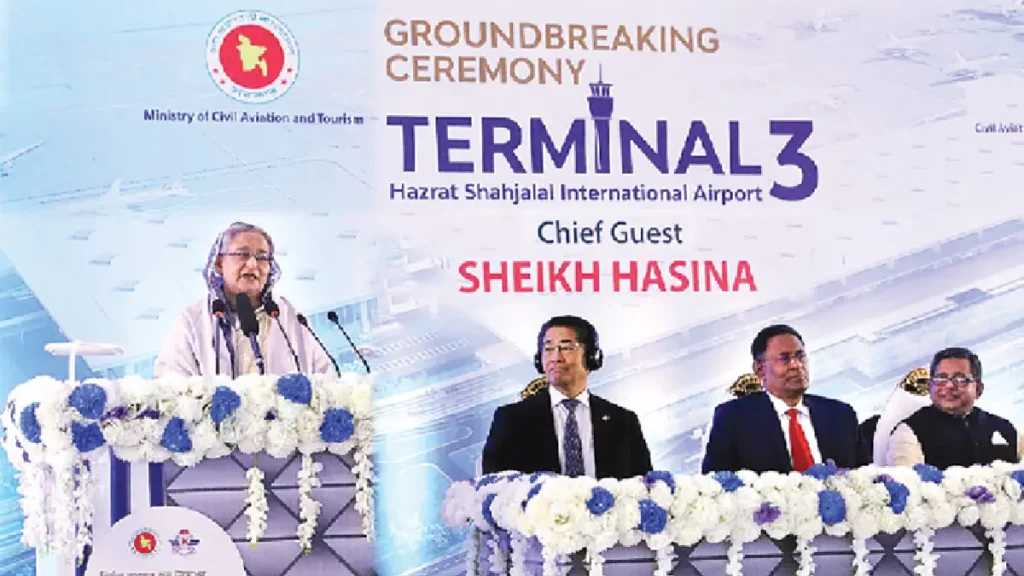In a much-anticipated moment, the third terminal of Hazrat Shahjalal International Airport had its soft opening on a Saturday morning, marking a significant milestone in the transformation of Bangladesh’s aviation sector. Prime Minister Sheikh Hasina inaugurated the state-of-the-art terminal, which stands as one of the most remarkable achievements among the ‘mega projects’ undertaken by the Awami League government.
Upon her arrival at the terminal, she was warmly received by State Minister for Civil Aviation Md Mahbub Ali. A delightful troupe of children greeted her with traditional dances and Bangla songs, and the Prime Minister graciously took pictures with them.
Subsequently, she embarked on a tour of the magnificent terminal, where she was briefed by Air Vice Marshal Mafidur Rahman, Chairman of the Civil Aviation Authority of Bangladesh (CAAB), about various aspects of the facility. To further emphasize the importance of this development, the Prime Minister participated in a dress rehearsal of the immigration process, including luggage checking and receiving a boarding pass. Once the formalities were complete, a special flight operated by the state-owned Biman Bangladesh Airlines took off from Dhaka, utilizing the newly constructed terminal.
According to the CAAB chairman, Terminal 3, a key component of the Shahjalal International Airport Expansion Project (Phase I), is nearing completion, with approximately 90 percent of its construction done. Besides the main terminal, the cargo complex, encompassing both export and import facilities, is also reaching its final stages and is expected to become operational by March or April.
Terminal 3 is poised to revolutionize the passenger experience with its cutting-edge facilities and options. It boasts 37 aircraft parking spaces, 26 boarding bridges (12 of which will be launched in October), and 115 check-in counters, including 15 self-service kiosks, promising a smoother journey for travelers departing from or arriving in Dhaka.
The terminal’s layout includes a ground-floor baggage handling system, a second-floor departure lounge and boarding bridge, as well as extensive duty-free shops and exit lounges. Once fully operational, Terminal 3 will have the capacity to serve a staggering 12 million passengers annually, a significant boost from the current capacity of 8 million passengers per year. Additionally, it offers amenities such as a multi-story car parking facility, customs hall, VIP and VVIP passenger areas, and a transit passenger lounge.
This three-storey terminal, designed by Rohani Baharin from the internationally acclaimed CPG Corporation (Private) Limited Singapore, boasts a spacious floor area of 230,000 square meters. Notably, Baharin’s portfolio includes the renowned third terminal of Singapore’s Changi Airport and Ahmedabad’s new international airport.
The project’s second phase will encompass the construction of a corridor and a multi-level car parking building with 1,350 parking spaces. In terms of passenger convenience, the new terminal introduces automated passport control or e-gates, reducing waiting times. Passengers can choose between self-immigration via the e-gates or assistance from one of the 56 exit immigration counters. Advanced safety measures include a modern fire-fighting system and enhanced security screening processes.
The terminal also features movie lounges, food courts, airline lounges, world-class duty-free shops, and facilities like Wi-Fi, mobile charging stations, prayer areas, and a Meeters and Greeters Plaza. Special provisions have been made for mothers, including breastfeeding booths, diaper-changing areas, and a family bathroom, while children have a dedicated play area.
Originally estimated at Tk 13,610.47 crore, the project received approval from the Executive Committee of the National Economic Council (ECNEC) in October 2017. Subsequently, the project’s vision expanded, leading to a world-class facility that holds the potential to transform the aviation sector in the long term. The final approved cost for the project stands at Tk 21,400 crore.
The Japan International Cooperation Agency (JICA), the Japanese government’s international development agency, has played a leading role in financing the project, with a consortium of three renowned international firms—Mitsubishi, Samsung C & T (the construction arm of Samsung), and Fujita JV—contracted to execute it. Notably, this marks Samsung C & T’s first project in Bangladesh, a company known for its involvement in iconic international landmarks such as the Burj Khalifa, Taipei 101, and the Petronas Towers.

